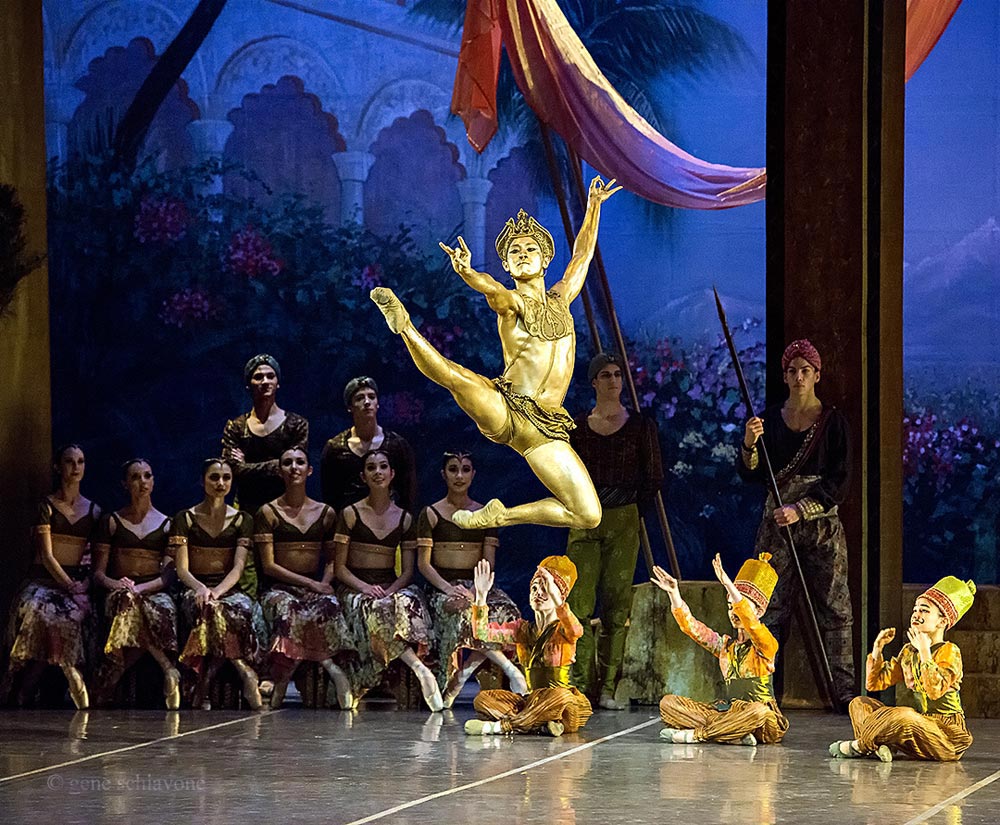
© Gene Schiavone. (Click image for larger version)
Boston Ballet
La Bayadere
Boston, Boston Opera House
24 October 2013
www.bostonballet.org
Boston Ballet opened its 2013-14 season at the Boston Opera House on October 24 with La Bayadere, featuring music by Minkus and choreography by Petipa. The ballet premiered in St. Petersburg in 1877 and was an immediate success, and it remains so in Russia but it’s rarely seen in the West. It tells the story of the doomed love between Nikiya, the “bayadere” or temple dancer of the title, and Solor, a victorious warrior whom the Rajah rewards with the hand of his daughter, Gamzatti. When Gamzatti learns that Solor is in love with Nikiya, she poisons her. In an opium dream, Solor is transported to the Kingdom of the Shades where he’s briefly reunited with Nikiya. (Most productions omit the original final act in which midway in the wedding of Solor and Gamzatti which is taking place in Nikiya’s temple, the gods destroy the temple and everyone in it.)
The ballet is considered a transitional work for Petipa, leading from the formulaic ballets of his early period to mature work characterized by such masterpieces as The Sleeping Beauty, Swan Lake, and Nutcracker. La Bayadere is also one of only two major ballets in which the leading woman is a dancer (the other is Giselle), so it gives Petipa ample opportunity for a preview of dazzling things to come, most memorably in the Kingdom of the Shades – probably the most famous dance in all of classical ballet. Soon after Nikiya’s death, Solor falls into an opium dream whereupon we hear glissandos on a harp and a woman in a tutu appears at the top of an inclined ramp at the upper right of the stage. She takes four steps forward, assumes a protracted arabesque, and takes one step backward, arching her back and raising one arm. She repeats the passage with a second dancer in her wake echoing her movements. They move forward and a third dancer appears, and so on.

© Gene Schiavone. (Click image for larger version)
The women descend partway down the ramp, turn a corner, and descend the rest of the way. When they arrive on the floor they turn again and continue this serpentine movement until 24 dancers face us in six columns of four each. (Many productions feature 32 dancers; 64 appeared in the first performances in St. Petersburg.) Nothing could be more simple, more powerful, or more beautiful. The effect grows slowly moment by moment with the inevitability of Greek drama. We can predict the outcome early on, but when the 24 women take their final positions, it’s as if some celestial harmony has been established. In choreographic terms, the dance is a proof of Mies van der Rohe’s dictum that “Less is more.” (It’s a minor miracle that in this production you see hardly a wobble in the dancers’ sustained balances. Kudos to this corps!)
As for the whole ballet, it’s a 19th century expression of the racist Orientalist view that says India is a land of groveling slaves and despotic rajahs, unbridled lust and pervasive corruption, abundant opium and yielding odalisques. The clichés are so thick you could cut them with a scimitar. Once past all that, however, it’s a lavish and thrilling spectacle with abundant pleasures for eye and ear.

© Gene Schiavone. (Click image for larger version)
I arranged to see in a single day what I thought would be the two best of the four casts, but I was disappointed at the matinee. Avetik Karapetyan was commendable as the Golden Idol and Anais Chalendard (a new Second Soloist this season) gave us a fiery and persuasive Gamzatti, but it’s disturbing to see how emaciated she is. I’ve often admired the elegant line and pleasing presence of Alejandro Virelles in the past, but this time he wasn’t in good form. His leaps lacked height and energy and he didn’t seem fully invested in his role, although he was an attentive and helpful partner throughout. He got little for his pains, however, since Ashley Ellis as Nikiya is one of the least expressive dancers I’ve ever seen. This is Ellis’s first season as a principal and she’s technically accomplished and has a lovely, limpid line, but emotionally, there’s nothing there. She’s so self-contained she creates the impression that she’s dancing only for herself. She desperately needs an acting coach who can explain to her that when her life is being threatened it might be well to express fear, and when she’s in love with a man it wouldn’t hurt to look at him once in a while. For all I know she may in fact experience emotion while dancing, but if so, she doesn’t convey it.
The evening cast was far better since it contained the company’s three best dancers: Misa Kuranaga as Nikiya, Kathleen Breen Combes as Gamzatti, and Jeffrey Cirio as Solor. Kuranaga is one of the most meliflous dancers I’ve ever seen, a vision of unfailing grace, and a good actress as well, while the personable Cirio brings great élan to all his roles. His dancing is strong and clean and confident, and he is a dashing and attentive partner as well. Combes is for my money one of the best women now performing, and she was riveting as Gamzatti. To see a performance with three such exemplary dancers is as good as it gets.
The Three Shades were excellent at both performances: Dusty Button, Rie Ichikawa and Whitney Jensen at the matinee and Dusty Button, Lia Cirio and Seo Hye Han in the evening. Han has just been promoted to Second Soloist, and she’s so unfailingly good that I predict another promotion in the near future. The admirable Jonathan McPhee conducted the orchestra with his usual intelligence and verve.

















You must be logged in to post a comment.